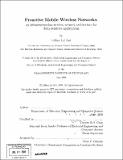| dc.contributor.advisor | Vincent W. S. Chan. | en_US |
| dc.contributor.author | Dai, Lillian Lei, 1978- | en_US |
| dc.contributor.other | Massachusetts Institute of Technology. Dept. of Electrical Engineering and Computer Science. | en_US |
| dc.date.accessioned | 2009-01-30T16:43:08Z | |
| dc.date.available | 2009-01-30T16:43:08Z | |
| dc.date.copyright | 2008 | en_US |
| dc.date.issued | 2008 | en_US |
| dc.identifier.uri | http://hdl.handle.net/1721.1/44409 | |
| dc.description | Thesis (Ph. D.)--Massachusetts Institute of Technology, Dept. of Electrical Engineering and Computer Science, 2008. | en_US |
| dc.description | Includes bibliographical references (p. 197-213). | en_US |
| dc.description.abstract | Infrastructureless wireless networks are an important class of wireless networks that is best suited for scenarios where there is temporary and localized telecommunication demand. Such networks consist of wireless devices that can form a network autonomously without the need for pre-deployed telecommunication infrastructures such as base-stations and access points. Over the past several decades, significant research and development efforts have been devoted to a particular type of infrastructureless wireless networks called mobile ad hoc wireless networks (MANETs). In addition to autonomous network formation, wireless devices in MANETs have routing capabilities and help one another to forward information in a multihop fashion. The applications envisioned for MANETs include communication during disaster relief, search and rescue, and small tactical unit operations where the existing telecommunication infrastructures may be destroyed or are unavailable. While significant strides have been made in all aspects of MANET networking, adoption of such technology has been limited to date despite its potential. We believe that this lack of adoption is due to a fundamental mismatch between application demands and the MANET network architecture. While the flexibility of anytime and anywhere communication offered by MANETs is appealing, these networks are not designed to provide assured service for delay-sensitive applications such as communication during a search and rescue mission or in a battlefield. In fact, MANETs may be frequently disconnected due to mobility and/or device failure. Such disconnections may persist for an unacceptable length of time, during which, there may be loss of critical time-sensitive information and degraded network performance due to mismatches to routing and transport layer protocols. | en_US |
| dc.description.abstract | (cont.) To provide service assurance in these scenarios, it is insufficient to limit technical improvements to the traditional networking layers (such as power control, coding, or routing) since network disconnections may still occur. We argue that a Proactive Wireless Network Architecture is needed - one that proactively maintains network connectivity in order to provide assured message delivery for applications with high quality of service (QoS) demands. The two key features of a proactive wireless network are: (1) Network disconnection prediction via localization, trajectory prediction, and large-scale channel estimation and (2) Network topology control via the adaptive deployment of additional wireless devices, called helper nodes, and by proactively controlling their movements toward regions of predicted disconnections prior to the occurrence of such disconnections. Hence, unlike MANETs, proactive wireless networks are designed to anticipate and respond to network disconnection events via active connectivity maintenance with helper nodes, thereby preventing network disruptions and message loss. In this dissertation, we present the proposed proactive wireless network architecture, quantify operating scenarios where the proposed network architecture is a sensible choice, and present system-level performance analyses under various helper node deployment schemes. | en_US |
| dc.description.statementofresponsibility | by Lillian Lei Dai. | en_US |
| dc.format.extent | 213 p. | en_US |
| dc.language.iso | eng | en_US |
| dc.publisher | Massachusetts Institute of Technology | en_US |
| dc.rights | M.I.T. theses are protected by
copyright. They may be viewed from this source for any purpose, but
reproduction or distribution in any format is prohibited without written
permission. See provided URL for inquiries about permission. | en_US |
| dc.rights.uri | http://dspace.mit.edu/handle/1721.1/7582 | en_US |
| dc.subject | Electrical Engineering and Computer Science. | en_US |
| dc.title | Proactive mobile wireless networks : an infrastructureless wireless network architecture for delay-sensitive applications | en_US |
| dc.title.alternative | Infrastructureless wireless network architecture for delay-sensitive applications | en_US |
| dc.type | Thesis | en_US |
| dc.description.degree | Ph.D. | en_US |
| dc.contributor.department | Massachusetts Institute of Technology. Department of Electrical Engineering and Computer Science | |
| dc.identifier.oclc | 289332268 | en_US |
